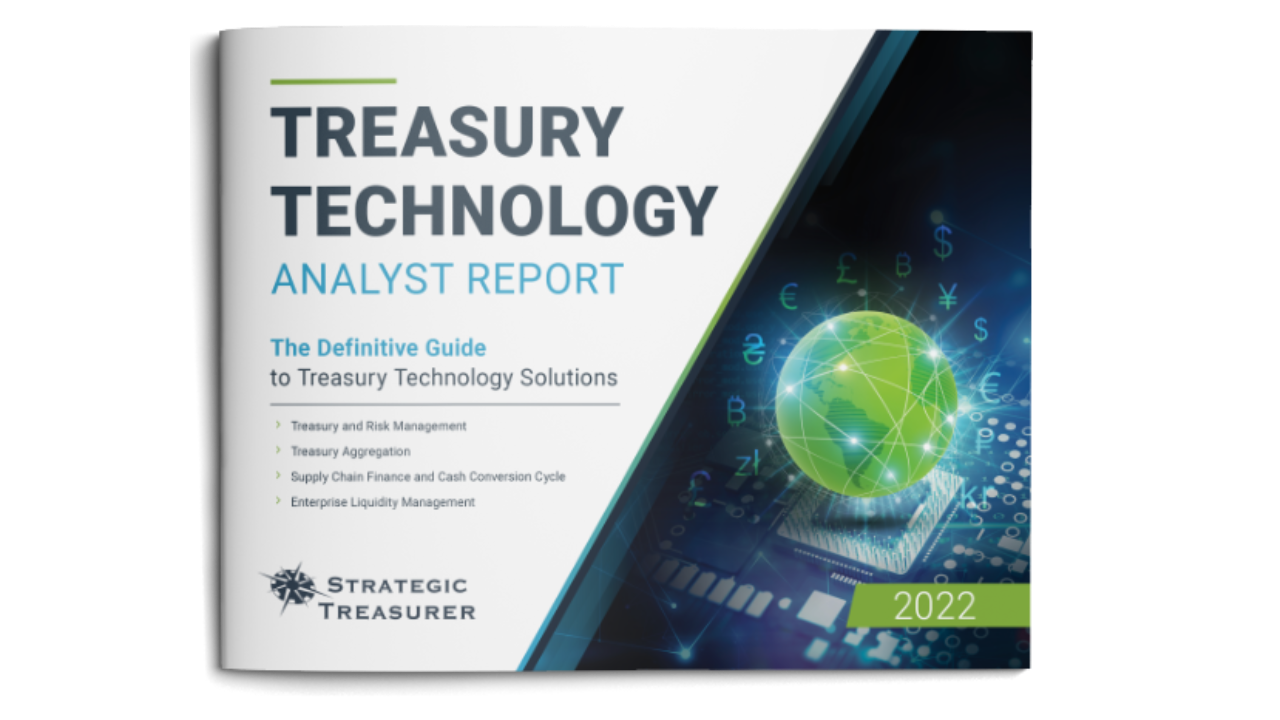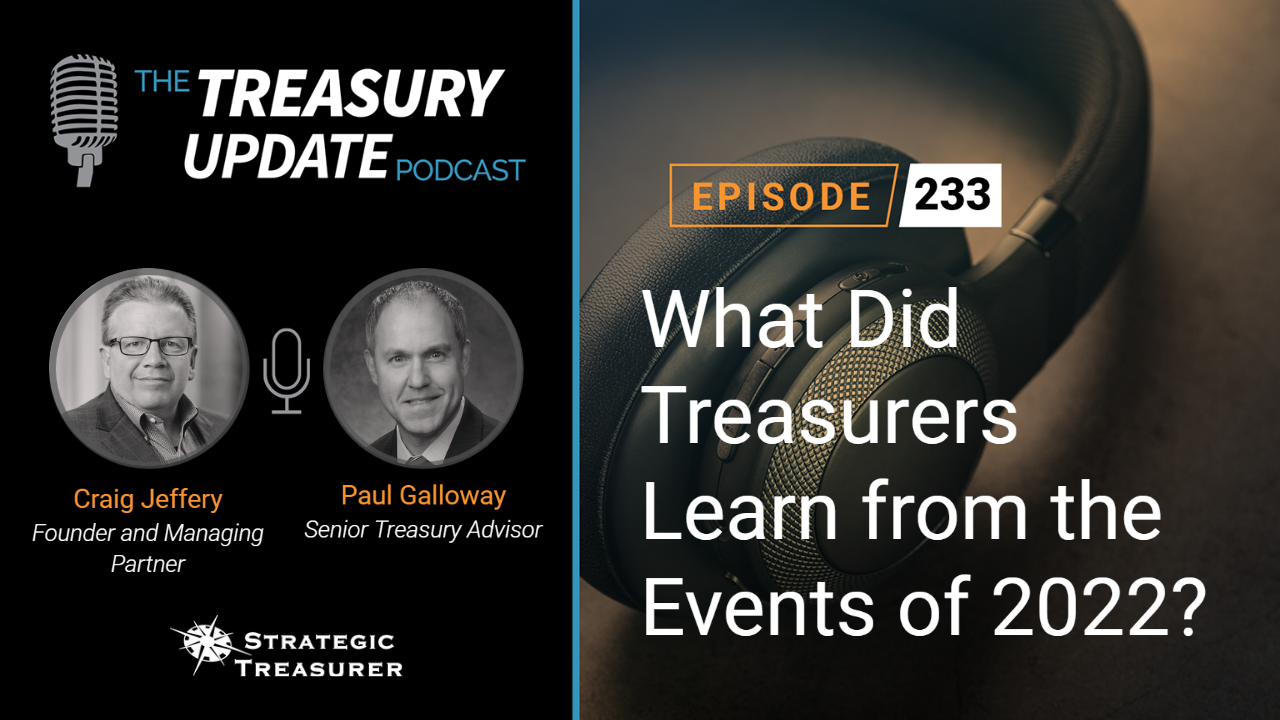
Episode 235
The Treasurers Have Spoken:
Survey Results on TMS, Payment Hubs, and the CCC
Craig Jeffery and Paul Galloway of Strategic Treasurer discuss the key findings and implications of recent survey data by Strategic Treasurer. They discuss the new advancements of APIs. Are they improving fast enough to keep up with market demands? They touch on the thought process involved in a Treasurer deciding on a payment hub, and the challenges treasury departments face in managing their cash conversion cycle.
Interested in hearing more? Sign up for the upcoming webinar and download the report.
Register for Analyst Report Series webinar on January 12, 2023, Treasury Management Systems & Enterprise Liquidity Management.
Download our Treasury Technology Analyst Report
Host:
Craig Jeffery, Strategic Treasurer


Speaker:
Paul Galloway, Strategic Treasurer


Episode Transcription - Episode #235 - The Treasurers Have Spoken Survey Results on TMS, Payment Hubs, and the CCC
Announcer 00:04
Welcome to the Treasury Update Podcast presented by Strategic Treasurer, your source for interesting treasury newsn analysis, and insights in your car, at the gym, or wherever you decide to tune in.
Paul Galloway 00:18
Welcome to the Treasury Update Podcast. I’m Paul Galloway, Senior Advisor at Strategic Treasurer. I’m joined today by Craig Jeffery, Founder and Managing Partner of the firm. And we are here to talk about the 2022 Analysts Report we just put up, you can find a copy of that on our website at StrategicTreasurer.com. And also in the show notes.
Craig Jeffery 00:41
And just so people know it’s extremely current, there’s a digitally fresh copy. There are also some physical copies. Most of those were handed out at the Association of Financial Professionals annual conference this past year in Philadelphia just a few weeks ago.
Paul Galloway 00:55
Yeah, I think we got really good response from folks on the Analyst Report. We had hard copies also QR codes for soft copies, and it was well received. Craig, I’d like to talk about treasury management systems or TMS systems today. We have a section in the report dedicated to treasury management systems. And I think one of the things that would be good to cover at the front end would be what are some of the recent trends in the TMS arena. Being at the AFP recently, they’re out there showcasing some of their more recent technology and things that they’re doing gearing up for future plans as well. What are you seeing out there? And you know, how did we present that in our Analyst Report?
Craig Jeffery 01:44
Yeah, so in the Analyst Report, we have multiple sections. So for those who are listening, there’s going to be a few other podcasts on this. We’ll talk about treasury management systems today a core area of treasury, they’ll also be a podcast, hopefully, Paul and I can talk about treasury aggregators, which includes the payment hub space. And we’ll look at supply chain finance and the cash conversion cycle, a number of solutions that fit into that. So it’s pretty comprehensive technology analyst report. There’s also a full section on treasury tech landscape, the category we’re we’ve named enterprise liquidity management, and a number of other pieces there for those who are interested in looking at the full scope. But Paul, to your question about some of the recent trends. In a TMS area, life has been quite good for treasury management system providers for over five years now, maybe over eight years, it’s been a very significant and growing area. So there’s increased adoption, what we saw a decade ago was new providers were all SAS, actually, almost two decades ago, most of the new systems were application service providers moving to SAS. And that’s been that’s been dominated in that space for for quite some time, there’s been this trend to an ongoing trend, maybe an acceleration, acceleration on a already accelerating trend of replacing older legacy systems. So moving to the new tech has been happening. So replacing older, either homegrown systems, or tech that might be client server, maybe some technology is not not updated as as frequently. So those are some of the recent trends in that space. So popular above trend, adoption and use and replacement. So those are some of the broader trends that we see. There’s certainly a lot of trends in the technology space as well.
Paul Galloway 03:46
Good points. So when we think about the adoption of technology, which certainly has been ramping up, we’re seeing more and more organizations, committing dollars towards treasury management systems and other technology to help them gain more visibility, do their jobs more efficiently, manage risk better, have those controls in place, generate reports, consume data for analysis, and more strategic views of what their business is doing from a cash perspective? What do you see going forward? You know, what’s the trend? Or what is the future of our treasury management systems? And is it more of the same with more bells and whistles? Or are we going to see a complete overhaul of how those systems are deployed, and how they change over a period of time?
Craig Jeffery 04:41
I think you might have been trying to break my brain with that question. There’s a whole bunch. You listed like 10 things and then you, you talked about kind of the macroeconomic elements that factor into what drives the use of tech and tech. So I’ll try to know is really good question and it’s It’s very comprehensive. I’ll break down my response this way. So why are TMSs, treasury management systems, becoming so popular? If you hear me say TMS, or Paul and I saying TMRS, treasury risk management systems, treasury management systems or treasury risk management systems, those are the category of systems that helps treasury manage liquidity, cash flow, risk on a number of fronts like FX risk or interest rate risk, support accounting controls, payments security. So what’s pushing this big drive? Well, there’s a lot of a lot of expectations placed on treasury groups, and they can’t meet the needs of their executive leadership, they’re requested to their executive leadership, ask of them. And I’ll say the demands of the new employees and treasury and finance. And I’ll break that down in a couple of pieces. So when you see what what is what is executive management, and the board expect from treasury, well, they want organizations to handle new risks, more proactively be able to see what the risks or threats are, and have plans either ready to go or in place that addressed these early on, not reactively, but much more proactively. So the expectations are higher. And this comes in an environment of we’ve seen inflation escalating, sitting at a much higher level, you know, above seven 8% In the US higher and other areas, a little more moderated and others. But escalating inflation puts pressure on those. Well, there’s also rising interest rates. And I know this is not a discussion about that at length, but you know, central banks have been pushing up rates, the cost of borrowing has been higher. So this creates other factors. And then there’s broader economic issues. Are we in a global recession? Are we in a regional recession? Is that going to happen? Throughout 2023, a number of those issues weigh in on the business. Plus, there’s all the business issues about the normal competitive cycle, access to certain goods or services, to support the financial supply chain as well as the business supply chain. So these create risk and challenges for companies. And the expectation is that treasury will be able to respond more rapidly. That’s one aspect that’s driving the need. And then increased adoption of treasury management systems. Despite some of these headwinds, economically, companies are not slowing down their investment there. And I think that’s a good piece of information have concerning your decision to use this type of tech? Why are people investing in it during times that may be uncertain is there’s there’s significant value to it to your second point about technology? What’s happening? What’s emerging on that front? And what do we expect over time? Well, one area that’s been in place for a while and you know, this really well is business intelligence tools and dashboarding, the depth on that has grown the capabilities and the depth as has grown quite significantly. I mean, when you think about dashboarding, a while a while back, let’s say five or 10 years ago, dashboards really weren’t much. They’re like reports. But now they’re much more they’re like dashboards or cockpits, or things that you can see adapt to, you know, as you learn, you can continue to drill in, make decisions or learn as you go. That’s one, Paul. The other two, I’ll just mention and give you a chance to jump into a couple other trends, the use of AI and machine learning the use of API’s, the idea of cloud native, or this decrease in the size of system elements and components that allow the development cycle to change. And I’ll pause there in case you want me to dive into any of those in particular.
Paul Galloway 08:48
Yeah, Craig, I think your closing comments there, and this are really good aspects to consider. Before I jump into that, just thinking about your comment on reporting, one of the things that I see for Treasury Departments having a dashboard that is more interactive is, as you put it, it’s it’s one of those things it talks about, there’s two ways you can go, you can be reactive or proactive. And historically, the way Treasury worked, it was more reactive, you saw something, you did something, and it was really kind of blocking and tackling or functional. And they’re taking steps forward with this kind of technology and dashboard that can inform them to make more proactive decisions. They can see what’s going on, not just today, but tomorrow, the next week, the week after that, and they can start positioning things and making decisions around how they manage their cash and their liquidity more effectively. So he becomes less reactive and more proactive. And, you know, I think that’s very encouraging that the technology is allowing them to do that. So you brought up API’s API’s are something that’s, you know, a hot topic. Lots of people if P we’re talking about API’s, and there’s all kinds of variations between what the banks are doing with the TMS TRMs providers are doing, everybody’s out there focused on API’s. And so are the, the clients, the customers that are focused on that as well. So can you provide some background on the API’s and what you expect to happen? As market demands for this connection between systems grows, what does that look like, and where it’s where’s it going?
Craig Jeffery 10:39
Sure API’s or application programming interfaces, that that term has been around for quite some time, though, its capabilities, the capabilities of API’s have differed significantly over time, just like, you may have had a portable phone. Well, that looked very different 30 years ago, 20 years ago, 10 years ago. And today, the same thing is true with API’s. And I guess one way to think about how that’s changing is, if we think about three different ways of connecting, let’s say, just to get information. One is I log into a portal, I punch in my codes, I see what goes on. And then maybe I have to rekey that information into a spreadsheet or into a system. The second might be, I want priority information, transaction information. And so I create, I have the bank, create a file that gets pushed to me through some type of file transfer process. And then that has to be loaded into a system. And there’s all so there’s the creation of a file, establishing a connection, the passing the file, the loading it, many, many steps to make that happen. And there’s time that’s involved in that. And it’s been a very effective method of communicating. An API is there’s no file, there’s the connection and the transmission of the information between systems into the system that you’re using, let’s say you want visibility to all your balance information. Well, that takes out a lot of those steps there is there is no file just like Neo in the in The Matrix, that 1999 movie, right? There’s like there is no spoon. There is no file, there’s this the the information transfers over transfers very quickly. Now, not every everybody needs instant, or super fast. But nobody wants slower. But the promise of the API’s is that it’s and what we certainly see is that as you work out the initial kinks, and we’ve we’re past that stage with many banks, we’re still doing better in that area just allows for faster information, less touch points. So we’re on the steep growth curve. That’s providing advantages. So, should someone rip out an existing host to host connection to put an API’s? Probably not unless you need something really, really timely. There’s a lot of strong features of what went before. But when you think about what do I put in from a new perspective, you’re gonna lead lean towards API. So this is really how people have open treasury, you’ve heard of open banking, this is I want to be able to consume information or have us in the in the system or on the the piece of glass that’s most important to me. And so this allows you to get that data from different areas in an easier to consume manner, just like on your, your phone, your rideshare app, it uses a map, there’s API’s to drive that your payment methodology is driven by API’s, it allows you to pull these together, view, act, or analyze on the pane of glass that you’re most interested in doing that. And so the adoption rates are going up really rapidly. They’re far higher than people expected them to be, like people that are expected to adopt them over the next couple of years, oftentimes adopt them within a year. So this is one of the few areas where expectations were lower than the actual adoption. Now the there’s a couple areas have slowed down not all the banks are on the road to API’s. And not all the banks are at the same level of effort and energy about building out so it’s a long transition. It’s not a one or two year transition. I think we need to think about, you know, five to 10 years for systems to get replaced or features to be added. Certainly the largest banks, the trillion dollar banks, the super regional banks are making good progress. It’s it’s quite a bit spottier below that level.
Paul Galloway 14:36
Yeah, Craig. Thanks. Those are great comments. You know, API’s are just going to become more and more familiar, I think across the board is as we move forward and time as you pointed out, companies are expecting this is the way everything’s going to move. And as you pointed out, also, adoption trends have been faster pace. That’s great to see. I think that It’s good across the board. But it’s it’s more of this marathon versus a sprint kind of approach just because they are complicated. It’s not that they’re, hey, I can just write this code and make this connection. And boom, it’s done. It takes significant effort. So it’s not, it’s not an overnight, one day kind of deal.
Craig Jeffery 15:20
Maybe it’s not a sprint, but maybe it’s not a marathon, either. Maybe it’s more of a short distance run compared to compared to the past. I mean, so I mean, we’re seeing the adoption of API’s across all of the technology that we use, for example, from provisioning data, lakes and blobs are very quick to set up from factoring in time recording systems, so that you can access a whole range of analytics, to connecting to your banks for information or for making payments. So when they get set up, it’s quick, but you need them with all your partners. So it’s a it’s a consistent spread in one direction, maybe it’s middle distance, I don’t know, somewhere along there.
Paul Galloway 15:59
Maybe it’s a 10k, or some half marathon. So certainly not that 100 meter dash. So let’s, let’s focus on artificial intelligence and machine learning, which, you know, these technologies are becoming more and more prevalent. You’re seeing TMS providers out there focusing on these two areas, that they’re part of their analytics, tools, forecasting, data management, being able to report when you think about AI and ML, where it is today, and the importance of it to Treasury from adleaks perspective, what are the key factors that Treasury Departments are focused on? And what does that look like? Going forward over, let’s say the next five years,
Craig Jeffery 16:48
Artificial intelligence, machine learning the idea of, you know, Can the system learn to think like humans do? component of that, you know, machine learning the ability to detect or determine patterns of things that have happened on a in a guided or an unguided manner? This is an area of significant growth. While API’s are really important on the connectivity side, that’s gonna be a big trend, AI and machine learning help as well, in a number of areas. So you asked Where Where will it impact? Where does pattern detection help? Where does understanding trends, everyone thoughts may go to forecasting. And we’re seeing, we’re seeing some decent progress with some of the TMS providers in making a forecast that works using some tools. This might be like a self driving car from some time in the past, it doesn’t handle every situation. So you do have to keep your eyes open and your hands on the wheels. But it’s going to be quite helpful in aiding what that process is, they get better and better. And those who have maybe simpler cash flows, more predictable cash flows, it does particularly well, there’s some other areas where there’s great variability, or there’s other items where the patterns aren’t as relevant, where the Tech has to catch up and, and do more to get on par with what the humans can do. This a big area forecasting is so important, nobody has time to do it. And the advancements here are pretty exciting. You can be a pessimist about this, or you can be an optimist. I’m leaning towards the optimist side, I think there’s been really, really good progress over the last couple of years, there’s quite a bit to go. But there’s good progress there. Patterns aren’t only in forecasts. And you can think about patterns for quality control, you know, you can do set up and have patterns detect what’s normal behavior. And so you can use that to catch criminals or potentially fraudulent items or errors. So this idea of quality control can catch errors, let’s say in a payment process ahead of time, or alert you to this falls outside the norm. Or it can help catch fraud, potential fraud, or real fraud to say this falls outside the norm. We see that being applied within TMS systems within treasury management systems, in a number of areas, especially those that are focused on more payment hub type functionality. So this this ability to detect fraud or anomalous behavior is really, really important because almost all fraud does follow some type of non standard anomalous pattern. Those are a couple areas that I think of and that we’re seeing development. I expect a massive amount of development in the next three to 10 years here and probably beyond that, but that’s as much as I can imagine right now.
Paul Galloway 19:40
Well, that sounds like really promising news for Treasury Departments that or considering this kind of technology or have this technology in place that they’ll be able to down the road here, get more and more out of AI and ML and help them with more than just forecasting, as you pointed out, I think that’s a great step forward, especially around the fraud protection piece. And we know fraudsters are becoming more and more savvy. And they’re finding more and more creative ways to take an organization’s cash, anything that can help them detect these anomalous activities. The things are out of the ordinary or that don’t seem bright, have something that is out of the ordinary. I think that’s just really beneficial to treasures the Treasury Department, you know, as a treasurer. Last thing you want to have happen is somebody comes in to the kingdom and is able to pilfer the gold. So one thing you don’t want it. It’s what keeps a treasurer up at night. And that was one thing I always worried about what I was, you know, in those kinds of roles, if somebody’s going to take the cash, being able to have some sleep insurance around, not worrying about you still worry about it. It’s part of the risk management, having these tools available to manage and mitigate that risk the best you can. That’s just great news for treasures. Well, Craig, this has really been enlightening. I really appreciate your time today talking about TMS. Looking forward to the other areas we have highlighted for the future Treasury update podcasts, we’ll be talking about payment hubs, and cash conversion cycle, and what that means for supply chain financing. Appreciate the time again, look forward to the next one.
Announcer 21:38
You’ve reached the end of another episode of the Treasury Update Podcast. Be sure to follow Strategic Treasurer on LinkedIn. Just search for StrategicTreasurer.com. This podcast is provided for informational purposes only, and statements made by Strategic Treasurer LLC on this podcast are not intended as legal, business, consulting, or tax advice. For more information, visit and bookmark StrategicTreasurer.com.
Subscribe to the Treasury Update Podcast on your favorite app!
Related Resources
Researching new treasury and finance technology can be overwhelming. Strategic Treasurer has stepped in to help. Explore our definitive guide to the treasury technology landscape and discover detailed, data-based coverage of each area.
What Did Treasurers Learn from the Events of 2022?
The year 2022 was an interesting ride. Global turmoil, supply chain issues, rising interest rates, and major acquisitions all caused concern and intrigue for treasurers and financial professionals around the world. In this podcast, Craig Jeffery and Paul Galloway of Strategic Treasurer discuss some of the key events of 2022.








